6 April, 2000
Buoyancy
Question 47: How much of the earth's fresh water is "locked up" in
Antarctica's ice?
The wind is howling today! It is gusting up to 50 knots, and the boats have
been taken out of the water because the surge against the shore is so rough.
From my desk I can look out and see waves breaking over the dock. A day to
respond to email, write journals and work in the lab rather than go outside!
On the days that we do go out and dive, there is one more very important
piece of equipment that we need. Even though all the things we put on are
very heavy (around 40 lbs.) we are still effectively wearing a large balloon
full of air. The dry suit and the air inside it make us buoyant even with the
SCUBA unit on. We have to add more weights to help us sink. The weights are
separate from all of the other gear and could be ditched (dropped) in an
emergency if we needed to go swiftly to the surface. We wear weight harnesses
that have pockets that we fill with bags of lead shot. I have around 40 lbs
of weight in mine. I also wear pound-and-a-half ankle weights to help keep my
feet from floating up.
The three states of buoyancy that we refer to for everything underwater are
positively buoyant, neutrally buoyant, and negatively buoyant. Things that
float are positive, things that sink are negative, things that hang motionless
at a depth without any external support are neutral. When we are neutral, we
sink a little when we exhale and float a little when we inhale. When starting
a dive we travel from the surface to the deepest depth we will be diving to,
so we want to be a little negatively buoyant. When we reach that depth, we
add air to our dry suits until we are neutrally buoyant.
It is actually a little more complicated than that because of the
characteristics of gas under pressure. The deeper we dive, the more water is
over us, and the more pressure is bearing down on our bodies and gear. The gas
(air) in our suits compresses as we descend and reduces our buoyancy. The
deeper we go, the more extreme our negative buoyancy. Since we do not want to
sink like rocks, we have to add air gradually to our dry suits as we descend
to control our rate. One of the reasons to maintain a gradual descent is to
be able to equalize our ears slowly (the same kind of ear popping experienced
going up in a plane or over high mountains). Another is to make sure we do
not drop too deep for safe diving (the official limit for diving with
compressed air is 135 feet).
A perfect descent will end with the diver hovering at the depth she wants to
start at without coming into contact with any of the solid objects she is
diving on. Contacting the substrate can stir up sediment and reduce
visibility, damage organisms that live on the surfaces, or alter the
substrate. A considerate diver does not drag across the bottom. On the
D-rings on the end of the shoulder straps I have tubing to hold my back-up
regulator and a tether for my gauges so that they do not scrape or tangle with
things on the substrate while I dive.
On the way back to the surface, the air in our suits expands as the pressure
decreases, and we have to vent some of it out of the suit. A diver should not
surface faster than 40 feet per minute, and shooting like a cork to the
surface is physically very dangerous. The exhaust valve is on the left upper
arm of the suit and can be closed or opened to vent automatically. To vent
air, the diver leans right, raises the left elbow until it is level with the
shoulder, keeping the hand lower than the elbow. Excess air travels to the
highest point in the suit and out the valve.
Answer 46: The biggest icebergs break off from ice shelves. The biggest was
found in 1956--it was about 58 miles wide and 201 miles long. In 1987, an
iceberg named B-9 broke off the Ross Ice Shelf. It was 22 miles wide and 96
miles long. It was also 750' deep and was estimated to contain 287 cubic
miles of fresh water. Go to http://uwamrc.ssec.wisc.edu/amrc/iceberg.html to
see satellite images of the most recent large iceberg, B-15, which broke off
in March 2000. It is about the size of Long Island in New York state.

Weight pouches filled with lead shot. Black are 5 lbs., blue 4 lbs., and red 3 lbs.

Weight harness. Quick release buckle is in the middle, also one on the shoulder strap. To dump the weights in an emergency, we would pull the yellow handles and the weight packets would fall off.
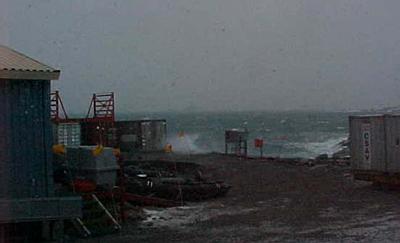
Spray from breaking waves blowing across the dock. Boats are out of the water.
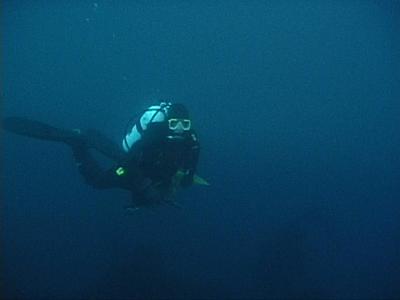
Now that she is neutrally buoyant, Katrin does not have to exert lots of energy to stay at the depth she wishes to explore
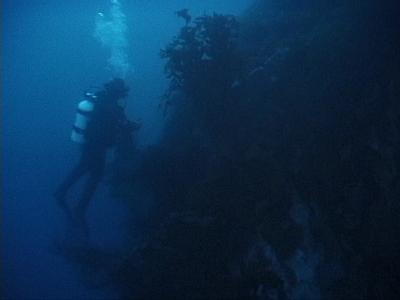
When diving a wall, such as this one off of Janus Island, that extends much deeper than a diver can go (+500 ft), it is very important to be in control of your buoyancy.
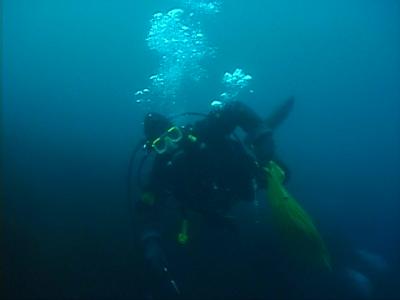
Katrin venting air out of her dry suit through the exhaust valve

At the end of a dive in good weather, divers enjoying floating at the surface without all of the heavy gear.
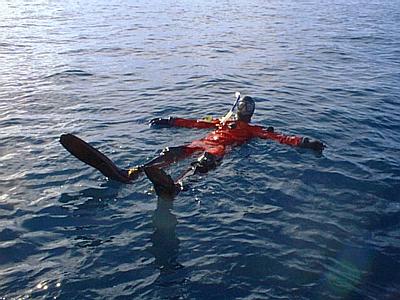
Bill Baker enjoying positive buoyancy at the surface.

Contact the TEA in the field at
.
If you cannot connect through your browser, copy the
TEA's e-mail address in the "To:" line of
your favorite e-mail package.
|
